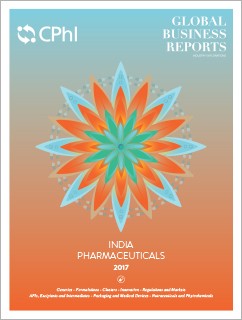
The Indian Drug Manufacturers’ Association (IDMA) has over 1000 members comprising large, medium and small national manufacturers across the country.
RELATED PUBLICATION
ARTICLES FROM THIS PUBLICATION
Daara B. Patel
SECRETARY GENERAL, INDIAN DRUG MANUFACTURERS’ ASSOCIATION
The Indian Drug Manufacturers’ Association (IDMA) was formed in 1961 and has acted as a bridge between the government and industry. What is the role of the association today?
With 20 committees headed by experts and very active state boards in Gujarat, Haryana, Himachal Pradesh & Uttarakhand, Tamilnadu, Puducherry & Kerala, Madhya Pradesh, Telangana, Karnataka and soon-to-be-formed State Board in Andhra Pradesh, IDMA effectively addresses all critically important matters related to wholly Indian pharmaceuticals. IDMA actively represents the Indian pharmaceutical sector and makes an all-round effort to drive the industry’s growth and enhance its presence all over the world. We also partner with Department of Pharmaceuticals in conducting joint seminars/workshops on GMP and other relevant issues.
How has the industry performed since we met in 2015?
India’s pharmaceutical sector touched US$36.7 billion in revenue in 2016, of which exports accounted for US$16.9 billion. The country’s pharmaceutical industry is expected to expand at a CAGR of 12.89% over 2015 to 2020 to reach US$55 billion with exports touching US$40 billion. The Indian pharmaceutical sector accounts for about 2.4% of the global pharmaceutical industry in value but 10% in volume and also accounts for 20% of global generics exports.
India is the largest generics producer in the world but has a growing emphasis on R&D. In what ways is the dynamics shifting?
So far, the thrust has always been towards generics, but it is now being spread to biotechnology. Major Indian pharmaceutical companies have been spending 8% to 9% of their revenue on R&D to produce innovative drugs in many therapeutic areas including cancer. Manufacturing of all-important vaccines and biosimilars has been growing at a steady pace since 2005. Our companies are also focusing on Novel Drug Delivery Systems (NDDSs) and value-added generics.
The IDMA has been working on a strategy to make India the largest global provider of safe and efficacious quality medicines at reasonable prices by 2020. How has this strategy developed?
The Government’s “Pharma Vision 2020” strategy is aimed at making India a global leader in end-to-end drug manufacturing. The policy will reduce approval time for new facilities to boost investments and, in the pharmaceutical sector, 100% foreign direct investment (FDI) is allowed under an automatic route.
IDMA’s “Journey towards Pharma Vision 2020 and Beyond” white paper is based on our suggestions to the government and deliberations with the government committees over many years. The document points towards a vision of the Indian pharmaceutical industry as a potential world leader by calling on government support to facilitate faster approvals to produce efficacious and affordable drugs, revive API and intermediate manufacturers to compete with countries like China, making provisions for cluster development, skill development and training, IPR, CROs and by addressing issues related to Indian and global regulatory agencies, export-import dynamics, brand building, accessibility and affordability, and so on.
In FY16, India exported pharmaceutical products worth US$16.89 billion, with the number expected to reach US$ 40 billion by 2020. How does India fare in competition for market share worldwide?
India has a competitive edge because of cost efficiency, portfolio diversification, economic drivers and policy support. Low cost of production and R&D boosts efficiency of Indian pharmaceutical companies – India’s cost of production is approximately 60% lower than that of the United States and almost half that of Europe. Due to lower cost of treatment, India is emerging as a leading destination for medical tourism. As of February 2017, India’s ability to manufacture high-quality, low-priced medicines presents a huge business opportunity for the domestic industry. In terms of portfolio diversification, India is the origin of 60,000 generic brands across 60 therapeutic categories and manufactures more than 500 different APIs. 35% of all drug master filings from India in 2015 were registered in the United States.
The Indian exporter is now going places. There has been a shift from the unregulated to the not-so-regulated markets and the tilt is now in favor of the highly-regulated markets, to which most of the strong exporters cater, such as Europe and the United States. Companies are also trying to move into Japan. In addition, Africa is a region of interest for many companies.
With Japan, we have already had two rounds of talks and met with their ministries and regulatory authorities. However, instead of an emphasis on pricing, which is our main consideration, they are more focused on quality and have a different pack size, which means repeating all the trials. Nevertheless the Japanese Government is now realizing that Indian companies are high-quality suppliers that also offer products at affordable prices, and therefore, will increasingly source from India.
What are the repercussions of increased U.S. Food and Drug Administration (FDA) stringency and other regulatory changes?
It is noteworthy that the highest number of FDA-approved units outside the United States is in India. Inspections are routine as part of regulatory exercise. The 483s from the United States go to every company and data shows that even a number of U.S. companies receive such warnings. There is nothing new in this. As the quantum of business increases, so does the chance of receiving these letters. Because of ever-increasing media activities and sensitive financial bourses these things are getting blown out of proportion; the quality of Indian medicines is well accepted all over the world. Our main focus should be on documentation, which is the main challenge in India. Our companies have now started documenting properly and we have rolled out data integrity training programs.
Within India, the regulatory authorities have prohibited manufacturing and marketing of almost 344 FDCs which were found to be irrational. The National Pharmaceutical Pricing Authority (NPPA) has fixed up ceiling prices for National List of Essential Medicines (NLEM) drugs marketed in India.
How do you foresee drug discovery capabilities playing out?
The Indian public is less financially well-off than citizens elsewhere. Secondly, there is no proper insurance provision in India. It therefore becomes difficult for our companies to pursue original-molecule research as there is not much market locally. Some companies are now increasing their R&D spend from about 3% to 8% or 9% but the shift will take some time. However, we are proficient in research for NDDSs and specialty generics. These developments enhance the value of the Indian pharmaceutical industry.
We have seen a closer relationship between academia and industry. Although this is not anywhere near even to China, Indian companies are seriously looking at academia to outsource some R&D activities to them.
Are government policies balanced when it comes to providing a favorable framework for industry?
India is a very large country with many people still living below the poverty line. We have a democratic system and government policies must be balanced to take care of the country’s people and ensure access to medicines. At the same time, the Government must support the industry to the extent they can. It is unlikely the industry will ever be freed from the shackles of price control. Though competition has contained prices to a large extent, there is need for some control and monitoring. The industry has become accustomed to this and the government tries to ensure the right balance.
India has a well-developed university infrastructure. How strong is the talent pool for skilled personnel?
Skilled personnel are available and we are trying to develop this talent further as a country. We are working closely with pharmacy colleges to encourage their students to come on board for a six-month period to understand the nuances of the manufacturing industry and to add value to the company straight away from the point of employment. As far as R&D is concerned, young researchers going abroad often settle there because of better research opportunities and career prospects as compared to India. R&D is still in its infancy in India and has less attraction. People are therefore less incentivized to return. We therefore may have some shortfall in highly-qualified R&D personnel in the near future.
Where do you see the most growth in the industry?
Our growth has been double digit for a long time. Over the next few years, the Indian pharmaceutical sector will grow at a faster pace than other global markets. While the patent cliff may adversely affect foreign multinational corporations (MNCs), this serves as an opportunity for India. The Indian healthcare sector, one of the fastest growing, is expected to advance at a CAGR of 17% to reach US$250 billion from 2008 to 2020. This again increases demand for quality medicines in India.
Our exports will certainly increase; more companies are looking at India for its quality, integrity and production capabilities. By 2020 there will also be a lot of convergence of companies to combine different strengths and synergies. This will further lower costs. Out of respect for patents and integrity, foreign companies will certainly have elevated confidence and outsource more to Indian companies.
From where do you see the strongest levels of competition globally?
As far as formulations are concerned, we do not have much competition. We have the economy of scale in our favor and our quality is well respected; it would take another country some time to compete with us. On the API side, China has taken over. We are in fact quite dependent on China for most of our APIs. We have advised the government to pool our resources to start basic research on APIs, excipients and other raw materials at competitive prices. Failing this, India will become more and more dependent on China. Despite the government’s promises, not much has changed on this front. The Government of India declared 2015 as “the year of the API”, but no substantial benefits have been provided so far
What are some of the key challenges to address going forward?
We have our own set of problems; there is a misnomer that certain products are under price control and others are not. From what we gather, everything is controlled. Prices of medicines under the national list of essential medicines, for example, cannot be increased because the government fixes the ceiling price and everyone must fall in line. Equally challenging is that if raw material prices increase across the country, we still do not get an automatic price increase. Each company must apply and seek a price increase. However, if the raw material price decreases, the price will be reduced immediately. Even when a price increase is sought, the process takes some time and some companies may close in the interim.
Although price control has long been a challenge, it is now becoming tougher. Our national pharmaceutical pricing authority wants more and more products to come under price control and they have a rule whereby no product price may be increased beyond 10% over a period of 12 months, even if there has been a huge increase in raw material prices. In effect, every product is under price control.
Do you have a final message to add?
Because of India’s position as a worldwide supplier of quality generics at affordable prices, the Indian pharmaceutical industry has earned its reputation as the “pharmacy of the world”. Very rightly, our theme this year is “Indian Pharmaceuticals, Nation’s Pride”.
The Indian industry has grown a great deal on its own steam. Now that the government support is there and countries such as Japan and many in Europe with ageing populations have budget constraints when it comes to healthcare, they have no choice but to look to India to get medicines. They must work closely with our regulators and companies to construct a mutually-beneficial relationship and think of India as a strong business partner.











